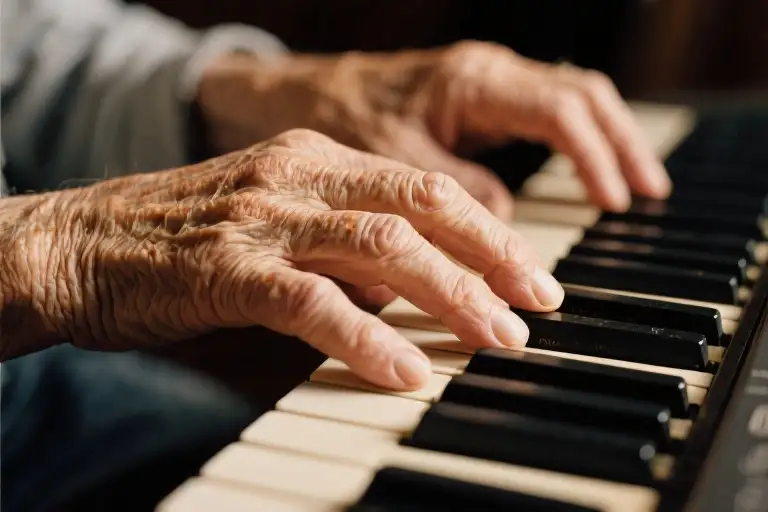The fluorescent lights hummed overhead, casting sterile shadows across the hospital bed. His hands lay still on the white sheets—too still. I counted the beeps of the heart monitor like they were lifelines, each mechanical pulse screaming the question I couldn’t voice aloud: Why didn’t you tell me?
We’d shared midnight snacks and inside jokes for years, yet somehow missed the tectonic shifts beneath his laughter. That’s the cruel paradox of silent suffering—it disguises itself so well in daylight. The same lips that joked about final exams had bitten back words heavier than textbooks, and none of us noticed until his body forced the truth into the open.
What startled me most wasn’t the crisis itself, but my own recognition. Standing there clutching the railing, I remembered pressing my forehead against bathroom tiles at 3 AM last winter, bargaining with the darkness to just hold on until morning. We become experts at folding pain into origami—smaller, neater, hidden in pockets where no one checks.
Research from the World Health Organization whispers the uncomfortable truth: nearly 50% of people with depression never seek help. Not because the pain isn’t real, but because giving it words makes it undeniable. There’s terrifying alchemy in speaking aloud—I’m not okay transforms from a thought to a fact, from something you might survive to something you must confront.
We’ve conflated silence with strength for so long. The cultural script praises those who “handle things quietly,” as if suffering were a test of endurance rather than a human experience needing witness. But silence isn’t a vacuum—it’s a pressure cooker. Every swallowed help me accumulates until the seams burst at their weakest point.
That night in the hospital, I finally understood: our deepest fear isn’t being broken. It’s speaking the breaking into existence, then meeting empty air where we hoped for hands to catch us. So we perfect the art of invisible drowning, smiling through “How are you?” while our minds whisper I’m underwater.
This is the modern loneliness—not lacking connections, but lacking the language to bridge the gap between what we feel and what others see. We mistake proximity for intimacy, assuming presence equals perception. But pain doesn’t always scream; sometimes it signs in braille, waiting for someone willing to touch the page.
The Anatomy of Silence
The cursor blinks mockingly in the message box, a digital metronome counting the seconds of hesitation. We’ve all been there—fingers hovering over keys, crafting then erasing those three dangerous words: I’m not okay. There’s something terrifying about making the intangible tangible, about giving shape to the formless weight we carry.
Psychologists call this emotional concretization—the moment internal chaos gets distilled into external language. Naming the pain means acknowledging its reality, and that’s precisely what makes us flinch. Studies show that 60% of people experiencing depressive episodes never seek professional help (WHO, 2021), not because they don’t recognize their suffering, but because speaking it aloud makes it irrevocably real in a way silent endurance doesn’t.
I keep thinking about the messages I’ve typed and deleted over the years. The drafts folder of my life filled with unsent cries for help—each one a small death of vulnerability. There’s a particular cruelty to modern communication tools; they give us the illusion of connection while amplifying our isolation. We stare at screens showing hundreds of contacts yet feel utterly alone, convinced our particular flavor of pain would be too bitter for anyone else to swallow.
This self-censorship follows a predictable pattern:
- The initial urge to reach out (a sudden surge of courage)
- The mental rehearsal of possible responses (most ending in imagined rejection)
- The catastrophic projection (If I say this, they’ll…)
- The retreat into familiar silence
Language becomes both the potential lifeline and the thing we fear most. In therapy circles, they talk about affect labeling—the paradoxical idea that verbally identifying emotions reduces their intensity. But when you’re drowning, the idea of stopping to describe the water feels absurd. What if naming the darkness gives it teeth? What if the words become anchors instead of buoys?
Yet the statistics whisper a terrible truth: unspoken pain grows heavier in isolation. That weight manifests physically—the slumped shoulders of someone carrying invisible burdens, the forced smiles that never reach the eyes. Researchers can now trace how repressed emotions rewrite our neural pathways, how silence literally reshapes the brain over time. The very thing we use to protect ourselves becomes what harms us most.
There’s a peculiar grief in realizing how many of us move through life as emotional archivists—carefully cataloging hurts we’ll never display, preserving wounds in private collections. We become curators of our own suffering, believing the exhibit would be too disturbing for public viewing. But museums need visitors to fulfill their purpose, and pain needs witnesses to begin healing.
The next time you find yourself deleting that message, consider this: the words you withhold might be the exact ones someone needs to hear to feel less alone. Your vulnerability could be the permission slip someone else has been waiting for to unpack their own silent suffering. Because in the end, language isn’t just a way to express pain—it’s how we dilute its potency, one shared truth at a time.
The Observer’s Dilemma
We’ve all been there—standing at the edge of someone else’s silence, sensing the storm beneath their calm surface but paralyzed by uncertainty. That moment when your friend laughs just a beat too long at their own misfortune, or when your partner insists “I’m fine” while their fingers grip the coffee cup like it’s the only solid thing left in their world. These are the unspoken cries for help we often miss, not because we don’t care, but because we’ve never been taught the language of silent suffering.
The Hidden SOS Signals
Silent distress rarely announces itself with dramatic breakdowns. More often, it wears the mask of normalcy—sometimes even exaggerated cheerfulness. The colleague who volunteers for every overtime shift might not be ambitious, but drowning. The class clown’s relentless jokes could be air pockets keeping them afloat in emotional depths. These behavioral paradoxes form what psychologists call “overcompensation patterns”—desperate attempts to conceal inner turmoil by overperforming socially acceptable roles.
Key indicators often include:
- The Perfectionist Plunge: Sudden obsession with flawless execution in one area (work, fitness) while neglecting other fundamentals (sleep, nutrition)
- Emotional Ping-Pong: Uncharacteristic mood swings between extreme productivity and complete withdrawal
- The Atlas Complex: Insisting on handling everything alone while refusing even minor offers of help
What makes these signals particularly insidious is their cultural reward system. We praise the overworked employee, admire the self-sacrificing parent, and idolize the always-strong friend—unwittingly reinforcing the very behaviors that mask deep distress.
When Help Hurts
Our instinctive responses often worsen the isolation we’re trying to alleviate. Consider these common but counterproductive reactions:
- The Silver Lining Brigade: “At least you have…” (invalidates present pain)
- The Tough Love Squad: “What you need is to toughen up” (implies failure)
- The Problem-Solving Posse: Immediately offering solutions (skips emotional acknowledgment)
These well-intentioned approaches fail because they prioritize our discomfort over the sufferer’s reality. When someone risks revealing their broken pieces, responding with “Let’s fix you” often translates as “Your brokenness is unacceptable.”
The Art of Bearing Witness
Effective support begins with replacing judgment with curiosity. Try these evidence-based alternatives:
- Instead of “Why didn’t you tell me sooner?” → “I notice this seems hard to talk about. Would it help if I just listened?”
- Replace “You should…” with “What would feel most supportive right now?”
- Swap “This too shall pass” for “This must feel unbearable at moments.”
These shifts create psychological safety—the assurance that one can express authentic emotions without fear of judgment or abandonment. Clinical studies show that simply feeling heard activates neural pathways associated with emotional regulation, often doing more than advice ever could.
The Permission Paradox
Here’s the uncomfortable truth: sometimes people stay silent because our reactions have taught them to. Every time we’ve subtly changed the subject when conversations got too real, every awkward pat on the back when someone cried, every “Let’s focus on the positive”—these become bricks in the wall of silence.
Breaking this pattern requires tolerating our own helplessness. Can we resist the urge to “make it better” long enough to simply say: “I don’t know what to say, but I’m here”? Sometimes the most powerful intervention isn’t having the right words, but having the courage to stay present in the uncomfortable silence together.
Because in the end, isolation isn’t just about being alone—it’s about believing no one can bear to see your truth. And the antidote isn’t perfect solutions, but imperfect presence.
The Icebreaker Experiment
There’s a particular kind of loneliness that comes from having words stuck in your throat. I’ve carried sentences like “I’m drowning” and “I can’t do this anymore” in my chest for weeks, polishing them smooth with worry until they became too heavy to release. The irony never escaped me – how the very act of swallowing pain made it grow larger, yet speaking it aloud felt like surrendering to its power.
The Three-Step Language of Survival
1. Speak in Metaphors First
When direct words fail, borrow from the world around you. “I feel like a radio stuck between stations” lands softer than “I’m completely lost.” These half-hidden confessions act as emotional airlocks – they let you test the atmosphere of vulnerability without full exposure. I started with “There’s a storm in my head today” texts to my sister, and somehow, describing the weather inside me made the forecast less terrifying.
2. Build Boundary Scaffolding
Before sharing, define what you need: “I don’t need solutions, just to say this out loud” or “Can we talk for 10 minutes? I’ll signal when I’m done.” This creates psychological safety nets. Like training wheels for emotional exposure, these guardrails prevent the free-fall feeling of oversharing. A friend once told me, “I can handle about three sentences of hard stuff right now – want to try that?” That measured approach made space for her to hear me without either of us drowning.
3. Action as Distress Signals
When language collapses, negotiate through movement: “Can we walk while I try to explain?” or “I need to sit outside for a bit – will you come?” The parallel activity absorbs some of the intensity. One man described bringing his brother to the garage where they “fixed” his depression by rebuilding a motorcycle together – the clatter of tools covering the silences between confessions.
The Observer’s Toolkit
For those standing on the other side of someone’s silence:
- Replace “Why” with “Where”: Instead of “Why didn’t you tell me?” try “Where does this hurt most today?” The shift from interrogation to mapping makes pain feel containable.
- The 70/30 Listening Ratio: Let their words fill 70% of the airtime, using your 30% for brief acknowledgments (“That sounds exhausting”) rather than advice or comparisons.
- Permission Prompts: “Would it help to talk through options, or just be heard?” honors their agency in the healing process.
Global Lifelines (When Words Fail Completely)
Sometimes the bravest sentence is “I need professional help.” These resources exist for those moments:
- International Association for Suicide Prevention (iasp.info/resources/Crisis_Centres)
- Crisis Text Line (Text HOME to 741741 in US/UK/Canada)
- Befrienders Worldwide (befrienders.org) for local hotlines
The paradox of silent suffering is that it convinces us we’re alone in our experience, while being perhaps the most universal human language. What we’re really learning isn’t how to speak pain, but how to translate between dialects of hurt – finding the phrases that bridge isolation without demanding more vulnerability than we can spare that day.
The Weight of Unspoken Words
There’s a particular kind of exhaustion that comes from carrying what you cannot name. Across cultures and generations, we’ve perfected the art of silent endurance – turning suffering into something resembling virtue. The Japanese call it “gaman” (我慢), that stoic perseverance through hardship. The British have their “stiff upper lip.” Americans glorify the “self-made” individual who never complains. We’ve built entire philosophies around the nobility of suffering in silence.
This cultural conditioning runs deeper than we realize. Historical records show medieval knights taking vows of silence as spiritual discipline. Victorian era etiquette manuals instructed women to endure pain without facial expression. Even our childhood fairytales rewarded characters who suffered quietly – Cinderella never protested her abuse, she simply waited for rescue. These narratives shaped our collective subconscious, equating emotional restraint with strength and vulnerability with shame.
Yet modern psychology reveals the devastating cost of this conditioning. Dr. Brené Brown’s research on vulnerability demonstrates how suppressing emotions actually decreases resilience. The MRI scans show startling physical differences – when we articulate pain, our brain’s amygdala (the fear center) shows decreased activity. Naming emotions literally makes them less overwhelming. Yet knowing this intellectually doesn’t automatically dissolve generations of cultural programming.
Perhaps what we’ve called “strength” was really fear in disguise. The fear that admitting struggle means failure. The fear that needing help makes us burdens. The fear that if people saw the cracks, they wouldn’t just see our brokenness – they’d define us by it. So we polish our surfaces while our interiors crumble, mistaking the performance of wellness for actual healing.
But something unexpected happens when we dare to voice the unspoken. That first halting confession – “I’m not okay” – often becomes the bridge others needed too. Like the Japanese art of kintsugi, where broken pottery is repaired with gold, our admitted fractures can become the very places where connection shines through. Your vulnerability gives others permission to acknowledge their own.
This cultural shift begins with small, deliberate acts:
- Replace “I’m fine” with “Today feels heavy”
- When asked about your weekend, mention the difficult moment alongside the good
- Practice saying “I need…” without self-deprecating qualifiers
These aren’t weaknesses – they’re revolutionary acts in a world that profits from our silence. Every time we voice an unspoken truth, we weaken the stigma’s power. The next generation won’t have to unlearn what we dare to change today.
What’s one sentence you’ve been carrying unspoken? Share it with someone safe, or if that feels too daunting, write it here as practice. Your words might be the permission slip someone else needs to break their silence.
The Weight of Words Unsaid
The hospital room was too bright, the fluorescent lights reflecting off the sterile surfaces in a way that made everything feel unreal. I stood there holding the phone where our last conversation still lived – twelve mundane texts about weekend plans, a meme about coffee, and three drafts of messages I now realized were cries for help that never got sent. The space between those ordinary words suddenly gaped like a wound.
We’ve all been there, fingers hovering over send. That moment when ‘I’m not okay’ feels heavier than carrying the pain alone. When typing the truth requires more courage than enduring another night of silent screaming into your pillow. What stops us isn’t lack of words, but the terrifying arithmetic of vulnerability – will this admission make things better, or simply make my pain more visible in a world that might look away?
This is the paradox of silent suffering: we isolate ourselves hoping someone will notice, while simultaneously building higher walls to ensure they don’t. The same hands that ache to reach out become experts at disguising tremors as laughter. We master the art of performative wellness – the Instagram posts showing brunch when we haven’t eaten in days, the ‘tired but happy’ captions over photos where our eyes tell a different story.
Yet here’s what they don’t teach us about emotional isolation: silence isn’t empty space. It’s active erosion. Every swallowed scream, every deleted draft, every ‘I’m fine’ chips away at our ability to believe we deserve rescue. The unspoken doesn’t disappear – it metastasizes into something harder to name.
So today, right now, let’s try something radical together. Not a grand confession, not tearing down all your walls at once – just one true sentence. Could be whispered to your bathroom mirror, typed to a friend who’s asked twice how you’re doing, or even just acknowledged in the notes app on your phone:
‘Today is harder than I pretend.’
‘I need______ (a walk, silence, to not be alone).’
‘This pain feels like______.’
No solutions required, no strength demanded – just practicing the alien grammar of letting your insides match your outside. Because here’s the secret no one tells you about breaking silence: the first words are always clumsy. They might come out sideways, too quiet, or with embarrassing snot involved. That’s not failure – that’s the sound of a long-sealed door creaking open.
The Japanese art of kintsugi repairs broken pottery with gold, understanding that the cracks become part of the object’s story. What if we treated our spoken pain the same way? Not as damage to hide, but as the very places where light could enter?
Your turn. One true thing. However small. However messy. However unheroic it feels to say ‘I’m drowning’ instead of continuing to perfect your underwater ballet.
Are you ready to be heard?





